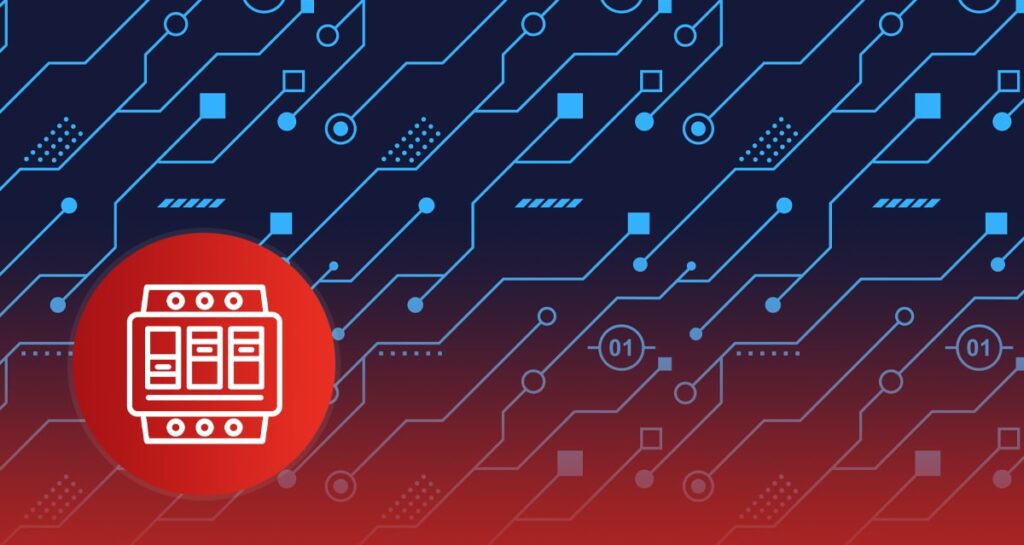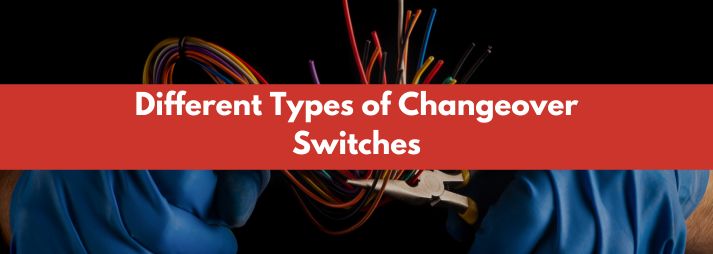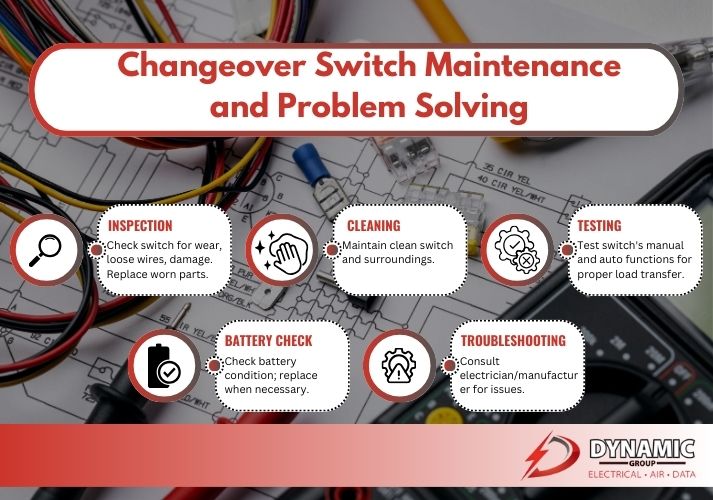Changeover Switches: Types, Installation & Selection

A changeover or transfer switch is a device that enables users to safely transfer their power to backup systems once the main power supply fails. The modern requirements of electrical dependency make these switches essential for continuous power delivery by reducing or fixing power outage periods.
Knowledge about how changeover switches operate and their application types and functions enables proper power management for residential, industrial, and commercial facilities. We will explain changeover switches by defining their operation, explaining their functions, and describing their various kinds and examples of application, emphasising their role in maintaining power continuity through generator backup power supply.
What is a Changeover Switch?
A changeover switch is an electrical device that selects between two power feeds through its main grid and backup generator connections.
The device provides uninterrupted power by enabling secure, effortless transitions between sources during interruptions, equipment maintenance, or source switching. Its main task is stopping interruptions with crucial equipment and essential systems.
The transition between power sources depends on the switch’s either manual or automatic functionality, which protects systems from electrical issues such as overloads and short circuits.
The design of changeover switches ensures reliable power connection to multiple sources, which enables continued supply until the principal power returns for both residential and commercial settings, mainly where power disruptions are frequent.
What is a Changeover Switch Used For?
You can use a changeover switch, automatic or manual, to direct a load between two available power sources. Every generator installation needs a changeover switch, which activates backup power as quickly as possible after a power outage occurs.
The protective mechanism of changeover switches creates safety by stopping electrical accidents during operations and properly disconnecting power sources. A changeover switch stands out among various electrical switches because it can redirect a load between sources, including backup generators.
Changeover switches become essential for power backup solutions in all electrical systems, from single-family residences to industrial facilities with several generators connected to the grid.
Changeover switches exist for several applications, which include:
Residential Applications
Changeover switches enable property owners to control power supply interruptions, allowing electricity to maintain uninterrupted flow. They also let users activate backup generators beyond standard outages and facilitate grid switching with alternative power sources for outage response and consumption management.
Commercial Establishments
Changeover switches provide automatic switching between sources, ensuring critical equipment like servers and data centres will keep operating. Businesses requiring uninterrupted operations should consider them because they ensure stable operations during power disruptions.
Industrial Settings
The changeover switch enables industrial facilities to perform safe, controlled switching functions between power sources. These devices keep manufacturing processes intact by shielding against power interruptions and voltage fluctuations.
Healthcare Facilities
Medical equipment that demands an uninterrupted power supply depends on changeover switches for operation. The automatic changeover switch operates as an essential item within hospital settings to maintain the power supply for essential life-saving equipment. Hospitals, clinics, and medical facilities use these switches to instantly transition into backup power systems when outages occur because such transitions guarantee vital life support systems and continual patient care operations.
Telecommunication Infrastructure
The changeover switch system eliminates power interruptions to telecommunication systems, thus maintaining a nonstop electricity supply. The devices are necessary to maintain a permanent electric supply, which enables continuous communication.
Emergency Services
The emergency response capabilities of fire stations, police departments and emergency response centres depend on changeover switches because of their critical importance in power transfer operations. Changeover switches guarantee power continuity for essential systems that consist of emergency lighting components, communication tools, and operational equipment.
Data Centres
The continuous operation of data centres depends on reliable backup power systems which protect the data from being lost. Changeover switches establish a smooth power transition from primary grid systems to backup generator supply to protect server and network operation continuity.
Remote Sites
Changeover switches provide advantages to energy systems that operate independently without traditional power grids by integrating alternative resources such as solar or wind power. The devices enable efficient power transfers between various resources to optimise energy consumption while preventing disruptions.
Benefits and Advantages
The main advantages provided by changeover switches include:
- Ensures uninterrupted power, minimising downtime.
- Facilitates a smooth and swift transfer between power sources.
- Equipment protects against damaging voltage changes, electrical surges, and destructive electrical interference.
- Enables operating between multiple power supply types because of its flexible design.
- The components easily link power supplies to one another.
- Blocks access to multiple power supply points at the same time.
- Suitable for various applications, from homes to industrial facilities.
- Operation efficiency and cost-effectiveness are benefits of its implementation.
Disadvantages
Many advantages exist with changeover switches, but they also have certain potential drawbacks:
- A high initial cost exists for purchasing expensive switches with premium features.
- The optimal performance of automatic switches requires periodic maintenance, which increases operational expenses.
- Automatic switch installations, as well as troubleshooting operations, tend to be more complicated than standard configurations.
- Automatic switches need power source sensors to operate, and their functioning depends on the reliability of the main power supply.

What are the Different Types of Generator Changeover Switches?
Two distinguishable types constitute the basic classification system of changeover switches, which exist in different models.
Manual Changeover Switch
The operation of manual transfer switches depends on human intervention to switch power sources. Depending on the model, this device operates through either a side lever mechanism or a push button.
The switch process’s control method shifts an internal connecting wire between different source power outlets. Manual switches possess simple operation and small size with easy installation, affordable cost, and easy operation capabilities.
Automatic Changeover Switch
Automatic changeover switches feature built-in smart electronic controls that perform independent power source switching operations. The system functions by using relays and solid-state devices while constantly tracking the power grid voltage levels.
The generator starts whenever the system detects weak voltage. When the main power returns, the system automatically turns away from the backup generator and shuts it down simultaneously.
These flexible devices allow customisable programming of their settings, which enables them to work optimally across diverse applications that need swift safety interventions regardless of power outages.
Installation and Operation of a Changeover Switch
A professional electrician who installs a changeover switch is needed to achieve safety and meet code compliance standards. The process includes:
- Assessment: The assessment step involves determining necessary power requirements, sufficient capacity, and appropriate switch types according to the number of power sources, types of loads, and future growth plans.
- Switch Placement: The placement of switches requires selecting an appropriate location that is conveniently accessible while providing proper ventilation near power sources and the load panel.
- Wiring: The installation process includes wire connection steps between the switch devices and load panel, using proper cables and corresponding sizes while following manufacturer standards and electrical codes.
- Testing: After installation, we should perform complete operation testing on the switch while verifying its safety features.
How Do You Wire an Electrical Changeover Switch?
A step-by-step procedure helps users wire a three-phase changeover switch while connecting it to residential/business electrical and generator main panels. These instructions function for manual and automatic switch types with only a method difference for operation.
Implementation of three-phase changeover switch wiring requires the following sequence of steps:
- The switch contains four terminals across its sides with L1, L2, L3 and Neutral terminals dedicated to three-phase utility power.
- The four rear upper terminals connect to the main electrical network, the four frontal upper terminals to the generator, and the four bottom terminals to the load.
- The upper and lower terminals need to operate in parallel for appropriate functioning.
- The safety requirement states that the switch body needs to establish contact with the ground.
- The load terminals must be connected to the incoming main terminal of your business or home.
Why Do I Need a Changeover Switch?
Changeover switches streamline power source transitions during power blackouts and other situations that require power changes. These devices enable users to change power sources, and this can be accomplished manually or by programmed switching methods.
The critical function of these switches is to stop the dangerous phenomenon of back feed, which allows power to flow unintentionally into incorrect lines, possibly causing harm to equipment, persons, and the electrical system. Changeover switches function to reliably separate circuits from each other, so they prevent dangerous power backfeed conditions.
Safety Considerations When Using Changeover Switch
Getting safe operation requires priority when using changeover switches in your work environment. Key precautions include:
- Employing a qualified electrician for installation
- Ensuring adherence to all electrical codes and safety regulations
- Regularly inspecting and maintaining the switch (checking connections, cleaning contacts, and testing its functionality)
- Clearly label the switch and power sources to prevent confusion.
- Providing thorough training to users on operation, features, and safety protocols
- Developing and practising emergency procedures for power outages or switch malfunctions

Maintenance and Troubleshooting of a Changeover Switch
The optimal operation of changeover switches requires constant maintenance practices. The following list includes important things you should do to maintain your changeover switch:
- Visual Inspection: Observation of the switch demands regular checks to identify signs of deterioration, loose wires, and broken parts. Replace any worn components immediately.
- Cleaning: The switch operations require a spotless condition between cleaning the device and its surrounding space from all collecting dust and loose debris.
- Testing: Routine checks should be conducted on both the manual and automatic functions of the switch to confirm that it operates easily and correctly switches power loads.
- Battery Check: Switches with backup batteries need regular inspection of their battery condition, followed by replacement when needed.
- Troubleshooting: Professional help who offers electrical services like electricians or inspection of manufacturer guidelines is needed to address any issues.
The reliable transition of electrical power between sources depends on changeover switches, which are vital elements in electricity systems. Manual or automatic switches operate to maintain a reliable continuous power supply, safeguarding systems and lowering equipment downtime. Complete knowledge about operational principles, along with the different types and installation techniques, helps achieve safe operational effectiveness.
Trusted Electricians Working with Changeover Switches
Setups with dual power require changeover switches as a critical safety measure. Your decision about the best power transition depends on your understanding of changeover switch functions and different product types.
Dynamic Group operates as the premier Perth electrical service provider of professional changeover switch solutions. Our team does electrical residential services as well as commercial electrical services by installing, replacing and repairing these switches. We have operated professionally for years in the electrical industry and we serve the entire Perth area.
Power outages become manageable when a generator installation is combined with a high-quality changeover switch. Dynamic Group installs various high-quality generator changeover switches that address multiple requirements to enhance the reliable operation of power systems.
Contact us now.
Unmatched Electrical Services
Explore our services and see why we're recognised as one of Perth's top electrical service providers. Our dedication to exceptional customer care, clear communication, and the unmatched expertise of our experienced team make us stand out.
Competive Rates
Clean Work Sites
5-Star Service
Licenced & Qualified
Get in Touch Now
Complete the form below to get a customised quote or to have your queries answered.








